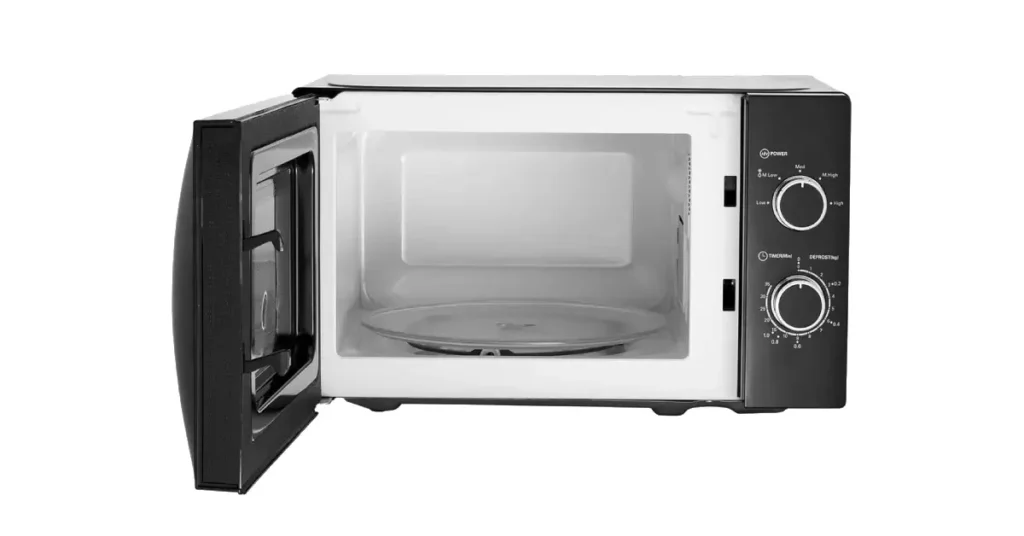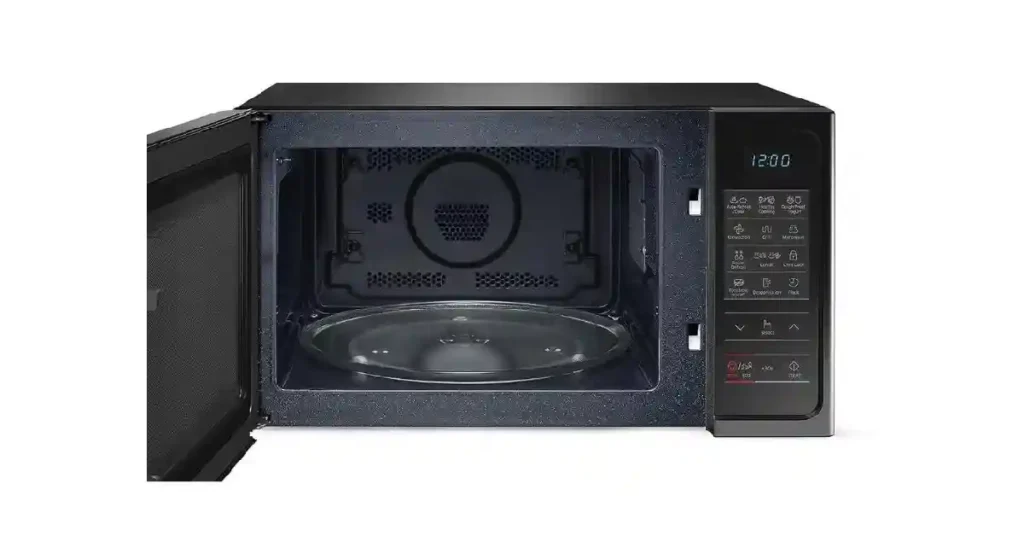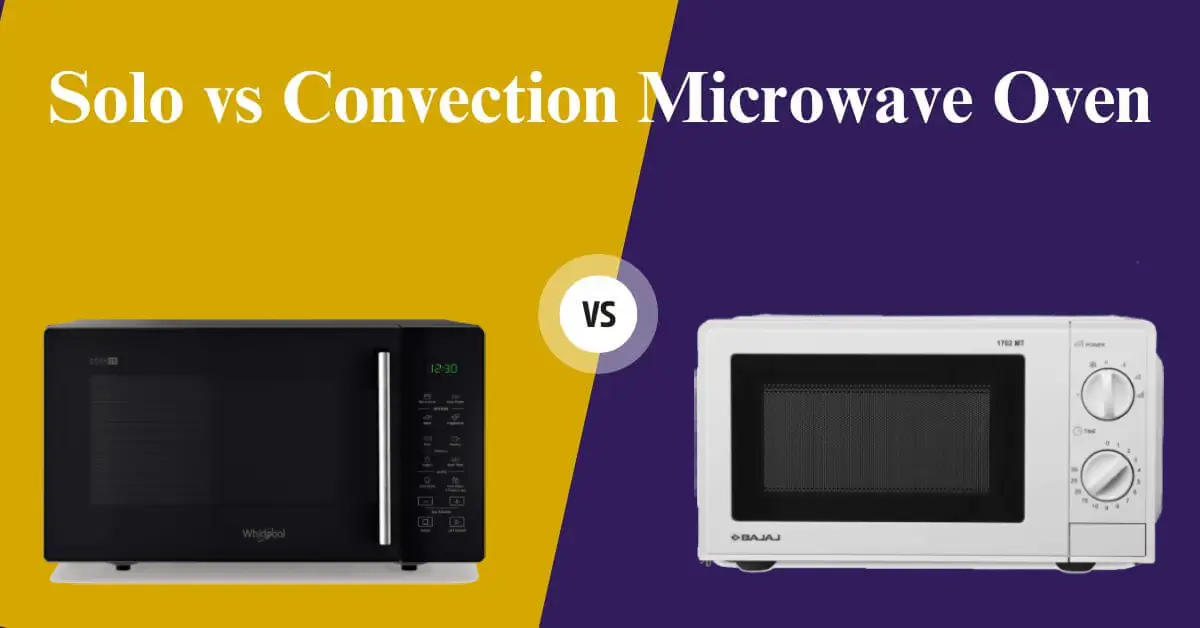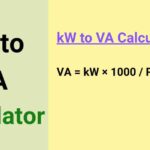Understanding the difference between Solo vs Convection Microwave Oven is critical to selecting the right kitchen appliance.
This guide, therefore, will present a breakdown of key features, advantages, and disadvantages of each option that will help you make an informed choice based on your cooking preferences.
With insights from experts as well as real users, this comparison will establish whether you should go for a simple microwave oven or its versatile convection alternative.
What is a Solo Microwave oven?

A Solo Microwave Oven is just one kind of microwave oven designed for simple cooking.
It uses electromagnetic waves to heat and cook food evenly without any advanced cooking features like in high-end microwaves.
Key Features:
#1. Basic Cooking Functions:
Great for warming, thawing, or doing light cooking.
#2. Uniform Heating:
Ensures that the food is heated equally through microwave radiation.
#3. Affordable Price:
Generally priced lower than other types of microwave ovens.
#4. User-Friendly Controls:
Often comes with easy-to-use mechanical or digital controls.
#5. Compact Design:
Usually small in size and excellent for kitchens with limited space.
Best Uses:
If you want a Solo Microwave Oven, then it’s perfect for tasks such as reheating meals, defrosting frozen foods, and cooking plain dishes such as noodles, rice, or veggies.
If you are looking for an uncomplicated and efficient appliance suitable for everyday kitchen chores, then this is the best option for you.
What is a convection Microwave oven?

The Convection Microwave Oven is a modern kitchen device that marries the characteristics of an ordinary microwave and convection oven.
This means it can warm up and cook food within short timeframes; it also allows for baking, roasting, or grilling.
Key Features:
#1. Dual Cooking Modes:
Fuses convection heating with microwave radiation enabling diverse cooking options.
#2. Even Cooking:
The convection fan ensures uniformity in heat distribution across the food surface.
#3. Grill Function:
Some models have a grill feature which can be used when browning or crisping foods.
#4. Pre-set Programs:
Usually comes with set default cooking programs for common dishes hence user-friendly.
#5. Versatile Appliance:
Acts as both a microwave as well as an oven therefore eliminating the need to buy other appliances for the kitchen.
Best Uses:
A convection microwave oven is perfect for making cakes, roasting meat, and grilling vegetables among many others.
Its multifunctional feature allows one to combine rapid microwave heat with baking and roasting properties in one small unit.
If you want to bake cookies, roast chicken, or just reheat some leftovers this is what you need.
Also Read: How to Use a Microwave Oven.
A Comparison Table Show the Differences Between Solo vs Convection Microwave Oven
The following table outlines major differences between Solo vs Convection Microwave Oven such as; cooking capabilities, size options, added features, and suitability for different types of cooking needs:
| Feature | Solo Microwave | Convection Microwave |
|---|---|---|
| Cooking Capabilities | Primarily for reheating and basic cooking tasks | Offers grilling, baking, and roasting functionalities |
| Size Variations | Available in 20L and 28L sizes | Options ranging from 20L to larger sizes suitable for large families |
| Additional Features | Basic functions with one-touch settings | Includes convection cooking, auto cook menus, and child safety lock |
| Suitability | Perfect for apartments and cooking simple meals | Ideal for those who enjoy baking, grilling, and roasting |
| Temperature Control | It is not possible to regulate the temperature in the majority of models. | The majority of models come equipped with temperature control features. |
| Working | Uses microwaves for Heating of the cavity | Use both heating the cavity and hot air |
| Price | More affordable than a convection microwave | More costly than a solo microwave |
Must Check: If you’re interested in learning about the differences between a Solo vs convection microwave oven, you may also enjoy our blog post comparing OTG and microwave ovens. This comparison is the culmination of extensive research and analysis, taking into account many factors. Be sure to give it a read.
Solo vs Convection Microwave Oven: The Advantages And Disadvantages
To get the right answer about Solo vs Convection Microwave Oven, you must know the advantages and disadvantages of each type individually.
solo microwave oven
A solo microwave oven is simply an appliance that uses microwaves to cook food in kitchens. However, it cannot be used for grilling, baking, or roasting but only for heating and defrosting. Some pros and cons include:
Advantages:
- Cheaper compared to other types of microwaves.
- Easy to use.
- Fast and convenient for simple cooking.
- Cleaning is simple.
- Defrosting can be done safely without any chance of cooking food.
- It cooks a lot of different kinds of meals that are good for microwave use.
- While cooking gently, it preserves nutrients as well as moisture.
Disadvantages:
- It cannot perform other cooking methods such as grilling, baking or roasting as it has limited functions.
- It can cause uneven cooking and hotspots due to microwaves concentrating in one area.
- Overcooking or lack of browning can make food dry or soggy.
- Large or irregularly shaped dishes are not suitable for them due to their small capacity.
- It is inappropriate for some foods that need high temperature, crispiness, and texture among others.
convection microwave oven
The convection microwave oven is one kitchen appliance that combines the features of a microwave and a convection oven.
It cooks faster and more evenly than an ordinary microwave, while also making food brown and crisp like a convection oven.
Below are some advantages and disadvantages of having a convection microwave oven:
Advantages:
- These include baking, roasting as well as grilling among others.
- As compared to the usual microwave or oven, it cooks at high speed while evenly done.
- Better results for crispy foods that require high temperatures.
- Preserve nutrients and moisture in food by using less oil and water.
- Can be stored in small spaces and easily used.
- To decrease the need for many kitchen utensils and facilities, it can save money and space.
- Using different modes and settings can provide more options for cooking and flexibility.
Disadvantages:
- When the convection feature is rarely used, then you are better off buying a regular microwave which is not as expensive.
- It requires constant maintenance and cleaning; otherwise, oil or other residues could affect its performance in cooking food making it dangerous to use.
- Besides having smaller interior capacity than traditional ovens, some meals may not fit into them because of their large sizes or irregular shapes.
- Food types and cooking modes may result in variations in cooking time and heat requirement thus requiring regular checks and changes.
- For instance, it cannot be used with certain types of safe dishware like plastic metal which may call for using special utensils together with accessories.
Factors to Consider When Choosing Solo vs Convection Microwave Oven.
#1. Kitchen Space and Size
Consider the available space in your kitchen alongside the machine size before deciding on buying a microwave.
With regards to microwaves, there are different types such as solo and convection ones available in compact countertop sizes or larger built-in models that can be installed.
Ascertain your kitchen layout by choosing an appropriate size that blends well with the cooking area hence allowing sufficient ventilation.
#2. Price Comparison: Solo vs Convection Microwave Ovens
Price differences between solo and convection microwave ovens are yet another important factor to consider.
In comparison to the solo ones, the convection type is usually a little bit more expensive because of its advanced cooking features.
Consider your budget and compare it with your desired characteristics to be able to make an informed decision that matches both your cooking requirements and financial capacities.
- The microwave oven price also depends on their type as well as other factors.
- For solo microwaves, prices range from ₹5,000 to ₹10,000.
- For Convection microwave ovens, the price varies from ₹8,000 to ₹18,000.
#3. Understanding the Grill Function in Microwaves
Grilling using a microwave oven saves time since you do not have to go out for grills.
A grill function is available in convection microwaves which brown and crisp effectively.
Consider whether or not you want a grill feature in your microwave oven and purchase one that suits your grilling needs.
#4. Energy Consumption
Microwave ovens come with an option to adjust the power, in which case a higher voltage equals increased efficiency and shorter cooking times.
When you usually cook heavy or large meals, it might be helpful to purchase a microwave with more power abilities.
However, if you normally make meals for one or two persons only, then a low-powered microwave would do.
#5. Automatic Cooking
A microwave with an auto-cooking feature is recommended for people who want to make their cooking process simpler. Unfortunately, this option is usually not present in low-end models.
With it, one does not have to manually set the time and power levels; just choose a dish that you are preparing and the appliance will do everything else.
#6. Defrosting
A microwave oven has a special function for defrosting frozen food.
#7. Safety mechanism for children
If there are young children in your home, they may accidentally stick their hands inside the oven.
This is why microwaves have child locks designed to prevent this from happening.
Normally, unlocking such lock codes resembles setting a password on your computer.
#8. Warming up
Preheating is the process of setting a microwave oven to the desired temperature and waiting for it to get there before starting to cook with recipes.
Before you can start cooking or following instructions, the oven has to get hot enough.
This needs turning the microwave on and allowing it to reach the right temperature, which is called pre-heating.
#9. The automatic cooking
The automatic cooking menu simplifies the process of cooking using a microwave. It works well for fast microwave fixes.
Instead of adjusting the wattage or cooking time, all you need to do with this feature is select the type of food you are preparing and it adjusts automatically according to its weight.
#10. Timer
The timer function on this device is so versatile and flexible as it can be set within a range of 30 seconds to 10 minutes.
Some types of control panels enable the user to alter cooking time by either turning a knob or tapping on an LCD screen.
#11. Types of Panels
There are three types of control panels available: Mechanical, Tact Dial Type, and Feather Touch.
Mechanical and Tact Dial Type panels are usually found in low-end models that can withstand rough handling.
Conversely, Feather Touch panels add beauty to your microwave. These touch-responsive screens are like those used in expensive mobile phones with higher ends.
#12. Microwave add-ons
Numerous microwave accessories can be found in the market, such as microwave oven gloves, microwave-safe cookware, utensils, bowls, and vessels.
Additionally, there are microwave stands available to mount on the wall if there is limited space on your kitchen counter.
A microwave oven cover can also be useful for covering the microwave when it is not in use.
FAQs
Is Solo microwave oven good?
However, a solo microwave oven is a simple type of microwave that can only perform basic functions like heating food, reheating, and defrosting. It is usually less expensive, smaller in size, and easier to use compared to other microwaves but its functionality is limited while the capacity is low. This means it cannot roast, brown, or bake food as a normal oven would do.
Is it worth buying a convection?
A convection oven on the other hand utilizes a fan and exhaust system which circulates hot air around the food hence making it cook faster and more uniformly. There are several benefits associated with the acquisition of convection ovens.
1. Better Browning and Crispier Texture.
2. Reducing Cooking Time And Temperature To Save Energy.
3. No Flavors Mixed With Multiple Dishes Cooked At The Same Time.
Can I bake in solo microwave oven?
It does not bake or grill like a convection microwave oven; if you need to bake using a microwave you should buy one of these types that have fans to circulate hot air within its chamber. A convection microwave oven also doubles up as a solo microwave oven.
Which is Better, a Solo or Convection?
You cannot bake or grill it like microwave convection or have to invest in one of these that has fans for hot air circulation in the chamber if you want to use it as an oven. A convection microwave oven is also a solo microwave oven.
Conclusion.
The size of the appliance and available space in your kitchen should be put into consideration whenever buying a microwave oven.
On the market, solo and convection microwaves are available in various sizes ranging from compact countertop choices to large built-in units.
Assess your kitchen design and select a size that fits perfectly without any barriers for ventilation purposes.
and pick one accordingly based on your grilling preferences. In this blog post, I will try to answer every important question regarding Solo vs Convection Microwave Ovens.
If you have any other questions please ask them by leaving me a comment below. If you liked this article, then consider sharing it with others too!










